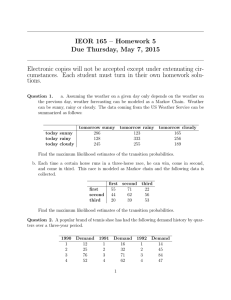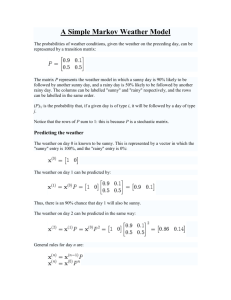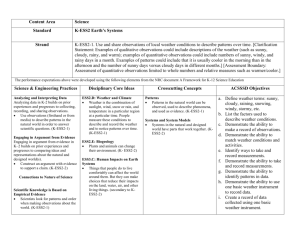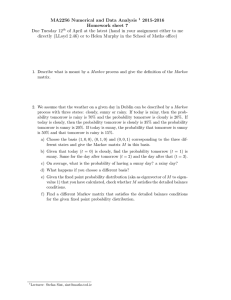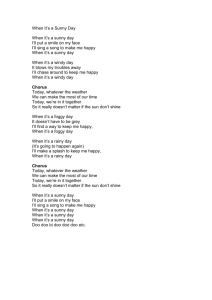Markov & Hidden Markov Models Tutorial
advertisement
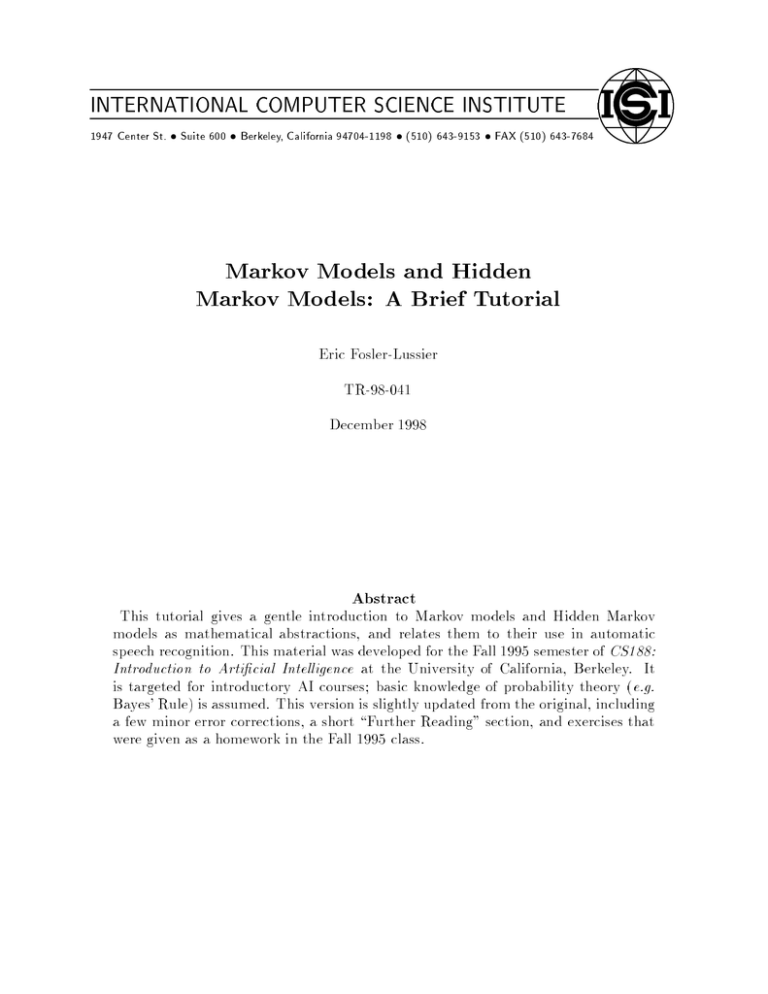
INTERNATIONAL COMPUTER SCIENCE INSTITUTE
1947 Center St. Suite 600 Berkeley, California 94704-1198 (510) 643-9153 FAX (510) 643-7684
I
Markov Models and Hidden
Markov Models: A Brief Tutorial
Eric Fosler-Lussier
TR-98-041
December 1998
Abstract
This tutorial gives a gentle introduction to Markov models and Hidden Markov
models as mathematical abstractions, and relates them to their use in automatic
speech recognition. This material was developed for the Fall 1995 semester of CS188:
Introduction to Articial Intelligence at the University of California, Berkeley. It
is targeted for introductory AI courses
basic knowledge of probability theory (e.g.
Bayes' Rule) is assumed. This version is slightly updated from the original, including
a few minor error corrections, a short \Further Reading" section, and exercises that
were given as a homework in the Fall 1995 class.
ii
1 Markov Models
Let's talk about the weather. Here in Berkeley, we have three types of weather: sunny, rainy, and
foggy. Let's assume for the moment that the weather lasts all day, i.e. it doesn't change from rainy
to sunny in the middle of the day.
Weather prediction is all about trying to guess what the weather will be like tomorrow based on
a history of observations of weather. Let's assume a simplied model of weather prediction: we'll
collect statistics on what the weather was like today based on what the weather was like yesterday,
the day before, and so forth. We want to collect the following probabilities:
( j n;1 n;2
(1)
1)
Using expression 1, we can give probabilities of types of weather for tomorrow and the next day
using days of history. For example, if we knew that the weather for the past three days was fsunny,
sunny, foggyg in chronological order, the probability that tomorrow would be rainy is given by:
P wn
w
w
: : : w
n
( =
j 3=
)
(2)
2=
1=
Here's the problem: the larger is, the more statistics we must collect. Suppose that = 5,
then we must collect statistics for 35 = 243 past histories. Therefore, we will make a simplifying
assumption, called the Markov Assumption:
In a sequence f 1 2
ng:
P w4
Rainy
w
F oggy w
Sunny w
Sunny
n
n
w w : : : w
(
P wn
j wn;1 wn;2 : : : w1) P (wn j wn;1)
(3)
This is called a rst-order Markov assumption, since we say that the probability of an observation
at time only depends on the observation at time ; 1. A second-order Markov assumption would
have the observation at time depend on ; 1 and ; 2. In general, when people talk about
Markov assumptions, they usually mean rst-order Markov assumptions I will use the two terms
interchangeably.
We can the express the joint probability using the Markov assumption.1
n
n
n
n
n
(
) = ni=1 ( i j i;1)
(4)
So this now has a profound aect on the number of histories that we have to nd statistics
for| we now only need 32 = 9 numbers to characterize the probabilities of all of the sequences.
This assumption may or may not be a valid assumption depending on the situation (in the case of
weather, it's probably not valid), but we use these to simplify the situation.
So let's arbitrarily pick some numbers for ( tomorrow j today), expressed in Table 1.
P w 1 : : : wn
P w
P w
w
w
Tomorrow's Weather
Sunny Rainy Foggy
Sunny 0.8
0.05 0.15
Today's Weather Rainy 0.2
0.6
0.2
Foggy 0.2
0.3
0.5
Table 1: Probabilities of Tomorrow's weather based on Today's Weather
For rst-order Markov models, we can use these probabilities to draw a probabilistic nite state
automaton. For the weather domain, you would have three states (Sunny, Rainy, and Foggy), and
1 One question that comes to mind is \What is w ?" In general, one can think of w as the START word, so
0
0
P (w1 jw0 ) is the probability that w1 can start a sentence. We can also just multiply the prior probability of w1 with
n
the product of i=2 P (wi j wi;1 ) it's just a matter of denitions.
1
every day you would transition to a (possibly) new state based on the probabilities in Table 1. Such
an automaton would look like this:
0.5
0.8
0.15
Sunny
Foggy
0.2
0.05
0.3
0.2
0.2
Rainy
0.6
1.1 Questions:
1. Given that today is sunny, what's the probability that tomorrow is sunny and the day after is
rainy?
Well, this translates into:
( = Sunny
P w2
w3
= Rainyj 1 = Sunny) =
( = Rainy j
( 2 = Sunny j
= ( 3 = Rainy j
( 2 = Sunny j
= (0 05)(0 8)
= 0 04
w
= Sunny 1 = Sunny) 1 = Sunny)
2 = Sunny) 1 = Sunny)
P w3
w2
P w
w
P w
w
P w
w
:
w
:
:
You can also think about this as moving through the automaton, multiplying the probabilities
as you go.
2. Given that today is foggy, what's the probability that it will be rainy two days from now?
There are three ways to get from foggy today to rainy two days from now: ffoggy, foggy,
rainyg, ffoggy, rainy, rainyg, and ffoggy, sunny, rainyg. Therefore we have to sum over these
paths:
( = Rainy j
P w3
w1
= Foggy) =
=
(
(
(
(
(
(
= Foggy 3 = Rainy j
2 = Rainy 3 = Rainy j
2 = Sunny 3 = Rainy j
3 = Rainy j 2 = Foggy)
3 = Rainy j 2 = Rainy)
3 = Rainy j 2 = Sunny)
= Foggy) +
1 = Foggy) +
1 = Foggy) +
( 2 = Foggy j 1 = Foggy) +
( 2 = Rainy j 1 = Foggy) +
( 2 = Sunny j 1 = Foggy)
P w2
w
w1
P w
w
w
w
w
P w
P w
P w
P w
2
w
P w
w
w
P w
w
w
P w
w
= (0 3)(0 5) + (0 6)(0 3) + (0 05)(0 2)
= 0 34
:
:
:
:
:
:
:
Note that you have to know where you start from. Usually Markov models start with a null start
state, and have transitions to other states with certain probabilities. In the above problems, you
can just add a start state with a single arc with probability 1 to the initial state (sunny in problem
1, foggy in problem 2).
2 Hidden Markov Models
So what makes a Hidden Markov Model? Well, suppose you were locked in a room for several days,
and you were asked about the weather outside. The only piece of evidence you have is whether the
person who comes into the room carrying your daily meal is carrying an umbrella or not.
Let's suppose the following probabilities:
Probability of Umbrella
0.1
0.8
0.3
Sunny
Rainy
Foggy
Table 2: Probabilities of Seeing an Umbrella Based on the Weather
Remember, the equation for the weather Markov process before you were locked in the room
was:
(
) = ni=1 ( i j i;1)
(5)
Now we have to factor in the fact that the actual weather is hidden from you. We do that by
using Bayes' Rule:
( 1
nj 1
n) ( 1
n)
( 1
(6)
nj 1
n) =
(1
)
n
where i is true if your caretaker brought an umbrella on day , and false if the caretaker
didn't. The probability ( 1
n) is the same as the Markov model from the last section, and
the probability ( 1
n) is the prior probability of seeing a particular sequence of umbrella
events (e.g. fTrue, False, Trueg). The probability ( 1
nj 1
n) can be estimated as
ni=1 ( ij i), if you assume that, for all , given i, i is independent of all j and j , for all 6= .
P w 1 : : : wn
P w : : : w
P w
P u : : : u
u : : : u
w
w : : : w
P w : : : w
P u : : : u
u
i
P w : : : w
P u : : : u
P u : : : u
P u
w
i
w
w : : : w
u
u
2.1 Questions:
w
j
i
1. Suppose the day you were locked in it was sunny. The next day, the caretaker carried an
umbrella into the room. Assuming that the prior probability of the caretaker carrying an
umbrella on any day is 0.5, what's the probability that the second day was rainy?
( = Rainyj
= Sunny 2 = True)
P w2
w1
u
=
(u2 and w1 independent ) =
( = Rainy 1 = Sunnyj 2 = T)
( 1 = Sunnyj 2 = T)
( 2 = Rainy 1 = Sunnyj 2 = T)
( 1 = Sunny)
P w2
w
P w
P w
w
P w
3
u
u
u
(Bayes 0 Rule ) =
( = Tj
= Sunny 2 = Rainy) ( 2 = Rainy 1 = Sunny)
( 1 = Sunny) ( 2 = T)
( 2 = Tj 2 = Rainy) ( 2 = Rainy 1 = Sunny)
( 1 = Sunny) ( 2 = T)
( 2 = Tj 2 = Rainy) ( 2 = Rainyj 1 = Sunny) ( 1 = Sunny)
( 1 = Sunny) ( 2 = T)
( 2 = Tj 2 = Rainy) ( 2 = Rainyj 1 = Sunny)
( 2 = T)
(0 8)(0 05)
05
08
P u2
P u
(P (A B ) = P (AjB )P (B )) =
P u
(Cancel : P (Sunny )) =
P u
=
=
w
P w
P w
(Markov assumption ) =
w1
w
w
P u
P w
P w
w
P u
w
P w
w
P w
w
P w
P u
P w
w
P u
:
:
:
:
2. Suppose the day you were locked in the room it was sunny the caretaker brought in an umbrella
on day 2, but not on day 3. Again assuming that the prior probability of the caretaker bringing
an umbrella is 0.5, what's the probability that it's foggy on day 3?
( =Fj
=
1 = S 2 = T 3 = F)
P w3
w
u
u
=
(
= Foggy 3 = Foggy j
1 = Sunny 2 = True 3 = False) +
( 2 = Rainy 3 = Foggy j ) +
( 2 = Sunny 3 = Foggy j )
( 3= j 3= ) ( 2= j 2= ) ( 3=
( 3= ) ( 2=
( 3= j 3= ) ( 2= j 2= ) ( 3=
( 3= ) ( 2=
( 3= j 3= ) ( 2= j 2= ) ( 3=
( 3= ) ( 2=
( 3= j 3= ) ( 2= j 2= ) ( 3=
( 3= ) ( 2=
( 3= j 3= ) ( 2= j 2= ) ( 3=
( 3= ) ( 2=
( 3= j 3= ) ( 2= j 2= ) ( 3=
( 3= ) ( 2=
(0 7)(0 3)(0 5)(0 15) +
(0 5)(0 5)
(0 7)(0 8)(0 2)(0 05) +
(0 5)(0 5)
(0 7)(0 1)(0 15)(0 8)
(0 5)(0 5)
0 119
P w2
w
w
=
:::
P w
w
:::
P u
F w
F w
F P u
F P u
j = )
) ( =
j 2= )
) ( 1=
j 2= )
) ( 1=
j 2= )
)
j 2= )
)
j 2= )
)
T w
F P w
F w2
P u
F P u
T P w1
T w
R P w
F w
P u
F P u
T P w
T w
S P w
F w
P u
F w
F P u
P u
F P u
T P w
P u
F w
F P u
T w
F P w
F w
P u
F P u
T
P u
F w
F P u
T w
R P w
F w
P u
F P u
T
P u
F w
F P u
T w
S P w
F w
P u
F P u
T
:
:
:
:
:
:
:
=
u
w
P u
=
u
P w
:
:
:
:
:
:
:
:
:
:
:
:
4
(
)
(
)
(
)
(
F P w2
S
R P w2
S
S P w2
S
F P w2
=
=
=
=
( =
R P w2
(
S P w2
=
= )+
1= ) ( 1= )
+
j
F w1
j
R w
j
S w1
S
S P w
S
S P w1
= )+
1= )
+
j
R w
j
S P w1
= ) (
F w1
j
= ) (
S w1
S
S
= )
S
= )
S
3 Relationship to Speech
Let's get away from umbrellas and such for a moment and talk about real things, like speech. In
speech recognition, the basic idea is to nd the most likely string of words given some acoustic input,
or:
argmaxw2L (wjy)
(7)
Where w is a string of words, L is the language you're interested in, and y is the set of acoustic
vectors that you've gotten from your front end processor2 . To compare this to the weather example,
the acoustics are our observations, similar to the umbrella observations, and the words are similar
to the weather on successive days.
Remember that the basic equation of speech recognition is Bayes' Rule:
(8)
argmaxw2L (wjy) = argmaxw2L (yjw()y) (w)
For a single speech input (e.g. one sentence), the acoustics (y) will be constant, and therefore,
so will (y). So we only need to nd:
P
P
P
P
P
P
argmaxw2L (yjw) (w)
(9)
The rst part of this expression is called the model likelihood, and the second part is a prior
probability of the word string.
P
P
3.1 Word pronunciations
First, we want to be able to calculate (yjw), the probability of the acoustics given the word. Note
that many acoustic vectors can make up a word, so we choose an intermediate representation: the
phone. Here is a word model for the word \of":
P
qb
P(q b | q a )
ax
ah
0.7
qa
Start
0.3
qc
1.0
1.0
v
End
qd
Figure 1: Word Model for \of"
In this model, we represent phone states as i 's. We can now break up (yjw) into (yjq w)
and (qjw). Since the picture above only talks about one word of , we leave the w out of the
conditioning here.
q
P
P
P
w
( j i) = ( jStart ax v End) + ( jStart ah v End)
(10)
( j of ) = ( bj a) ( 0 j b) ( c j b) ( 1 j c) + ( dj a) ( 0 j d ) ( cj d) ( 1 j c) (11)
The individual ( ij i) are given by a Gaussian or multi-layer-perceptron likelihood estimator.
The transitions ( j j i) depend on the pronunciations of words3 .
P y
P y w
P q
P y
P q
w
q
P y
P y
q
P y
P q
q
P y
q
P q
q
P y
q
P q
q
P y
q
q
q
2 This is usually an n-dimensional vector which represents 10-20 milliseconds of speech. A typical value for n is 8
to 40. Your mileage may vary based on the type of system.
3 I've made a simplifying assumption here that for the word \of" we only have two acoustic vectors, y and y .
0
1
5
3.2 Bigram grammars
In the second part of expression 9, we were concerned with (w). This is the prior probability of
the string of words we are considering. Notice that we can also replace this with a Markov model,
using the following equation:
(w) = ni=1 ( ij i;1)
(12)
What is this saying? Well, suppose that we had the string \I like cabbages". The probability of
this string would be:
P
P
P w
w
(I like cabbages) = (IjSTART) (likejI) (cabbagesjlike)
(13)
This type of grammar is called a bigram grammar (since it relates two (bi) words (grams)).
Using a higher order Markov assumption allows more context into the grammars for instance, a
second-order Markov language model is a trigram grammar, where the probabilities of word n are
given by ( nj n;1 n;2).
P
P w
w
P
P
P
w
4 Further reading
I have only really scratched the surface of automatic speech recognition (ASR) here for the sake
of brevity I have omitted many of the details that one would need to consider in building a speech
recognizer. For a more mathematically rigorous introduction to Hidden Markov Models and ASR
systems, I would suggest (Rabiner 1989). A recent book by Jelinek (1997) gives a good overview of
how to build large-vocabulary ASR systems, at about the same level of rigor as Rabiner. Hidden
Markov models can also be viewed as one instance of statistical graphical models (Smyth et al. 1997).
Other recommended introductions to HMMs, ASR systems, and speech technology are Rabiner &
Juang (1993), Deller et al. (1993), and Morgan & Gold (forthcoming).
5 Exercises
Imagine that you work at ACME Chocolate Factory, confectioners extraordinaire. Your job is to
keep an eye on the conveyor belt, watching the chocolates as they come out of the press one at a
time.
Suppose that ACME makes two types of chocolates: ones with almonds and ones without. For
the rst few problems, assume you can tell with 100% accuracy what the chocolate contains. In the
control room, there is a lever that switches the almond control on and o. When the conveyor is
turned on at the beginning of the day, there is a 50% chance that the almond lever is on, and a 50%
chance that it is o. As soon as the conveyor belt is turned on, it starts making a piece of candy.
Unfortunately, someone has let a monkey loose in the control room, and it has locked the door
and started the conveyor belt. The lever cannot be moved while a piece of candy is being made.
Between pieces, however, there is a 30% chance that the monkey switches the lever to the other
position (i.e. turns almonds on if it was o, or o if it was on).
1. Draw a Markov Model that represents the situation. Hint: you need three states.
Now assume that there is a coconut lever as well, so that there are four types of candy: Plain,
Almond, Coconut, and Almond+Coconut. Again, there is a 50% chance of the lever being on at the
beginning of the day, and the chance of the monkey switching the state of the second lever between
candies is also 30%. Assume that the switching of the levers is independent of each other.
However, we don't know a priori how long a word is. In order to handle multiple lengths of words, self-loops are often
added to the pronunciation graph. Thus, one can stay in state qb with probability P (qb qb) we can then handle these
probabilities like any other transition probabilities on the graph.
j
6
2. Now draw a Markov Model for both production of all four types of chocolates.
3. What is the probability that the machine will produce in order: fPlain, Almond, Almond,
Almond+Coconutg
Now assume that you can't tell what's inside the chocolate candy, only that the chocolate is light
or dark. Use the following table for (colorjstu inside):
Inside
P(color=light) P(color=dark)
Plain
0.1
0.9
Almond
0.3
0.7
Coconut
0.8
0.2
Almond+Coconut
0.9
0.1
Assume that the prior probability of P(color=light)=P(color=dark)=0.5, and that the color of
one chocolate is independent of the next, given the lling.
P
4. If the rst two chocolates were dark and light respectively, what is the probability that they
are Almond and Coconut respectively?
Acknowledgments
The weather story for Markov models has been oating around the speech community for a while it
is presented (probably originally) by Rabiner (1989). Thanks to Su-Lin Wu, Nelson Morgan, Nikunj
Oza, Brian Kingsbury, and Jitendra Malik for proofreading and comments. Any mistakes in this
tutorial, however, are the responsibility of the author, and not of the reviewers.
References
Deller, J., J. Proakis, & J. Hansen. 1993. Discrete-Time Processing of Speech Signals . New
York: Macmillan Publishing.
Jelinek, F. 1997. Statistical Methods for Speech Processing . Language, Speech and Communcation
Series. Cambridge, MA: MIT Press.
Morgan, N., & B. Gold. forthcoming. Speech and Audio Signal Processing . Wiley Press.
Rabiner, L. 1989. A tutorial on hidden Markov models and selected applications in speech
recognition. Proceedings of the IEEE 77.
||, & B.-H. Juang. 1993. Fundamentals of Speech Recognition . Prentice Hall Signal Processing
Series. Englewood Clis, NJ: Prentice Hall.
Smyth, P., D. Heckerman, & M.I. Jordan. 1997. Probabilistic independence networks for
hidden Markov probability models. Neural Computation 9.227{270.
7

